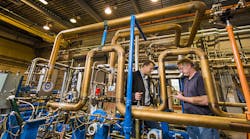Because renewables still only account for a fraction of energy consumed in the United States, the Department of Energy is searching for more efficient ways to generate electricity with fossil fuels. Sandia National Laboratories, recently revealed plans to design a fossil fuel system based on a supercritical carbon-dioxide Brayton cycle.
The energy conversion system will transfer heat from burning fossil fuels into a supercritical CO2 fluid—a state of carbon dioxide that has a liquid density while in a gaseous state. The supercritical CO2 will turn a turbine that generates electricity as it turns. Due to its high thermal stability, the fluid will significantly reduce the amount of energy lost to operate the turbines.
The project will be based out of Sandia’s Brayton Laboratory in Albuquerque, N.M. The laboratory is planning pilot tests using a 6-megawatt turbine developed by Peregrine Turbine Technologies. The turbine, currently under development, will use supercritical-CO2 as the working fluid. David Stapp, Peregrine's chief executive, said that the system could be around 30% to 60% more efficient than current steam technology.
Gary Rochau, manager of Sandia’s Advanced Nuclear Concepts department, said that the research was focused on advancing the "commercial readiness" of the S-CO2 Brayton cycle. He added that the conversion system would consume less fuel than traditional Rankine cycles while producing the same amount of energy. The Brayton cycle has environmental advantages, reducing the cost and emissions of fossil-fueled power plants.
Rochau said that while the program is focused on fossil fuel systems, it could result in big improvements to nuclear, geothermal, and solar production. The energy department, for instance, recently disclosed that it was testing the Brayton cycle process in concentrating solar power plants.
Other organizations participating in the research include Vacuum Process Engineering; Mid-South Engineering; CFD Research Corp.; the U.S. Space and Rocket Center at NASA’s Marshall Space Flight Center; Government Energy Solutions; and the Energy Huntsville Initiative.

